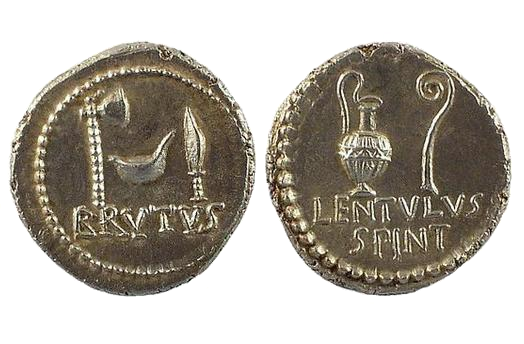
about ancient nomos
Ancient Nomos Art is a museum of galleries exhibiting ancient coins and ancient mint maps. The coin gallery displays the diverse art and history of hand-crafted ancient Greek, Roman, Byzantine, Persian and Medieval coinage. The ancient mints mapping gallery features Greek, Roman, Byzantine, Asia Minor and Medieval mint city regions and territories. Visitor's are welcome to explore, study and enjoy Ancient Nomos Art.

Roman, Republic – 42 BC
Marcus Brutus
From Ancient Galleries

Obverse: Simpulum between sacrificial axe left and knife to right; Brutus below.
Reverse: Jug to right, lituus to left; moneyor P. Cornelius Lentulus Spinther below.
LEGEND
Obv. BRVTVS, Simpulum (small vessel or ladle) between Securius (sacrificial axe) and Secespita (knife); beaded border. Rev. LENTVLVS SPINT, Capis (ceremonial jug) and Lituus (augural staff); beaded border.
This historically important denarius is known as Imperatorial coinage, which refers to the quasi imperial status of Rome’s government between Caesar’s rise to power in 60 BC, through Augustus being declared 1st Emperor in 27 BC. The coin was struck by Brutus just two years following Caesar’s assassination on 15 March 44 BC. The historical events leading up to the rise and fall of Brutus are complex. He was well educated, an accomplished writer and also versed in stoic philosophy and oration. He was a member of the aristocracy and served as Legate, Proconsul and Praetor under Caesar. He claimed his ancestral lineage descended from the original Brutus who helped institute the 1st Roman Republic, after removing the last King of Rome, Tarquinius Superbus, from power in 509 BC. Some believe his forefather’s legacy was the rationale for Brutus joining the conspiracy to kill the new “Dictator” Caesar, enabling him to also declare restoration to the Roman Republic. Regardless of motive, Rome’s clear path toward imperial rule would have been difficult for one man to reverse. After Caesar’s murder, Brutus became an outcast and was forced to live in Greece. He soon developed new Macedonian allies and was able to form a small army. This coin was struck in his name and by his military mint stationed in Smyrna in early 42 BC. The coin was in part payment to Soldiers for combat against an Octavian army, while also a sign of his imperial stature. The obverse depicts the sacrificial axe, small jug and knife used to symbolize the allegiance to the Roman College of Pontifices. The legend BRUTUS appears below. The coins reverse depicts a Capis jug on the left and an Augural Lituus staff on the right, symbolizing Rome’s priestly College of Augurates. Below is the abbreviated legend, P. Cornelius Lentulus, official coin moneyor and also elected Augurate. Ironically, Brutus used the same dagger that assassinated Caesar to commit suicide in October 42 BC.
DOCUMENTATION
Value: Denarius. Metal: AR Silver. Weight: 3.93 grams. Mint: Military mint moving with M. J. Brutus and G. Cassius, likely near Smyrna. Moneyor: P. Cornelius Lentulus Spinther. Date: Early 42 BC.
Attribution: M. Crawford 500/7; E. A. Sydenham 1310; RSC I 6; CRI 198.
Legend, Documentation and Attribution
